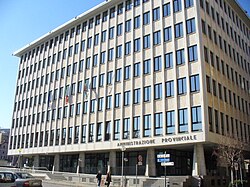Province of Savona | |
|---|---|
 The provincial seat | |
 Map highlighting the location of the province of Savona in Italy | |
| Country | |
| Region | Liguria |
| Capital(s) | Savona |
| Comuni | 69 |
| Government | |
| • President | Pierangelo Olivieri |
| Area | |
• Total | 1,546.29 km2 (597.03 sq mi) |
| Population (2025) [2] | |
• Total | 267,119 |
| • Density | 172.748/km2 (447.416/sq mi) |
| GDP | |
| • Total | €7.667 billion (2015) |
| • Per capita | €27,221 (2015) |
| Time zone | UTC+1 (CET) |
| • Summer (DST) | UTC+2 (CEST) |
| Postal code | 12071, 17010, 17012-17015, 17017, 17019-17028, 17030-17035, 17037, 17039-17043, 17046-17047, 17100 |
| Telephone prefix | 019, 0182 |
| Vehicle registration | SV |
| ISTAT | 009 |


The province of Savona (Italian : provincia di Savona; Ligurian: provinsa de Sann-a) is a province in the Liguria region of Italy. Its capital is the city of Savona. The province has a total population of 279,754. [4]








